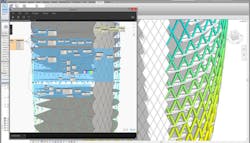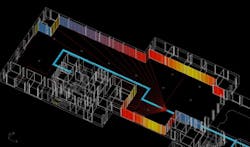3 things to consider for computation in the business of design
Design Intelligence’s 2015 Technology Trends and Innovation report cited that firms anticipated a number of computation-centric concepts to have significant impacts on business in the coming year. Among the concepts listed were “pervasive computing”, and “design by algorithm”. There can be little doubt that these processes are taking hold in a significant way for architecture and engineering companies. Companies such as Woods Bagot, NBBJ, and Thornton Tomasetti have positioned computational design as more than just another delivery tool: it is becoming central to the business of design.
Many of Proving Ground’s recent collaborations have been focused on developing business roadmaps for growing these capabilities in practice. While it is easy to get caught up in the hype about the possibilities for new tools, it is important to prioritize tactics that can help a business work towards scalable solutions that yield productivity and value.
In creating a roadmap for computation in practice, there are three things I like to consider when helping an organization achieve a meaningful implementation.
The Software is Cheap, Invest in the Right People
Have you seen the price point for computational design software lately? Grasshopper is a free plugin. Dynamo is open source (mostly). Learning to code has never been more accessible. In fact, building up computational capabilities looks quite different when compared to expensive investments in BIM and CAD software.
As with most things that drive success in service organizations, people should be the real focus of business investment for executing a successful computational design strategy. Design organizations should be looking for do-it-yourself creative thinkers that have a knack for making digital tools.
The good news is that computational design skills are becoming more commonplace among emerging professionals. However, computation is made meaningful only when combined with a firm’s design principles and business ethos.
Both/And – Specialized Staff, Distributed Skillsets
Historically, the most common model I have observed for implementing computational design has been for a firm to focus on creating a specialized team that acted as a hybrid of R&D skunkworks and project hit squad. This strategy is highly beneficial for the cultivation of a critical mass of expertise. However, there are limits to how this approach can scale in a larger company.
I often recommend that a company think about how a range of skillsets can be built up to encourage broader participation, skill growth, and engagement across an organization.
So what’s the right mix?
While the mix may vary greatly per organization, I like to think about the makeup of a computation-enabled design staff as being composed of a 70/20/10 ratio: 70% should have enough working knowledge to be able to ‘pull the levers’ on pre-made computational tools, 20% should have comfort level building simple tools and modifying complex project algorithms, and 10% should have an advanced skillset in creating sophisticated tools and solutions.
Having a computation-enabled team also means that project leadership and management have enough knowledge to be able to calibrate the process and give the team a platform to deliver valuable design solutions.
Defining the Business Value is Key
While computational design is an important trend in the architectural design world, the value is not implicit. I am often confronted with questions akin to some variation of “can Grasshopper or Dynamo do [x]” with the assumption that there is a set of predefined features for a specific use case. The reality is quite the opposite: computational design is about the process of creating solutions. The question is better framed as “What can we create that will help us better solve [x] design problem.”
The value of computation is greatly dependent on how an organization is able to position the new skillsets, tools, and workflows relative to the business. For example, creating a computational algorithm can greatly increase the speed of solving repetitive design problems. Creating a new tool for a project or market can provide an advantage for a firm looking to differentiate services in a competitive marketplace.
Computational design is a powerful, open-ended methodology. For it to be meaningful to a business ‘at scale’ means determining the desired outcomes coupled with a strategic framework for developing a team capable of creating impactful solutions.
About the Author

Proving Ground
Proving Ground is an AEC consulting practice that creates data-driven building processes that increase productivity, provide certainty, and enhance the human experience. As strategic advisers, the firm works with business leaders to define strategic plans focused on innovation with data. As educators, they teach your staff new skills by facilitating classroom-style workshops in advanced technology. As project consultants, they work with teams to develop custom tools and implement streamlined workflows. https://provingground.io/


